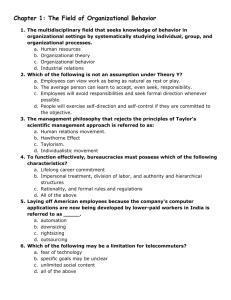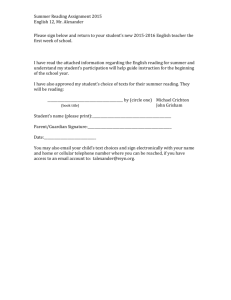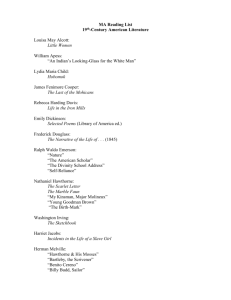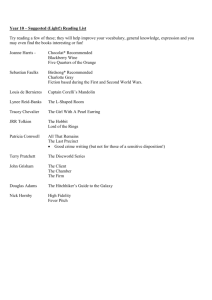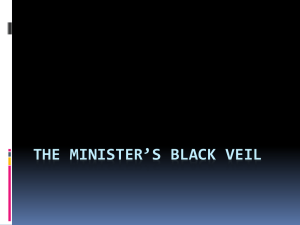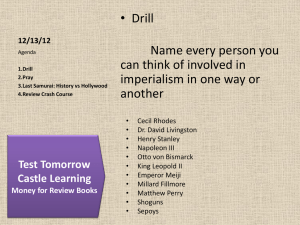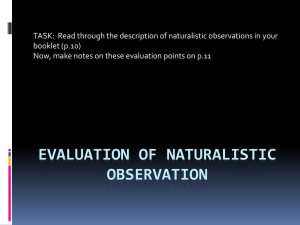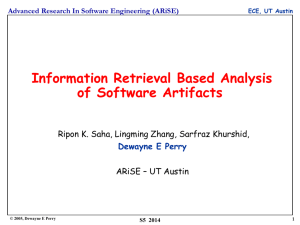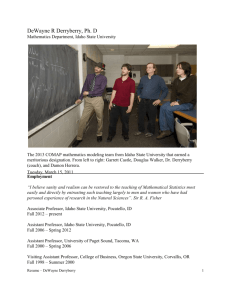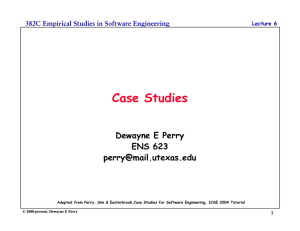workshop presentation
advertisement
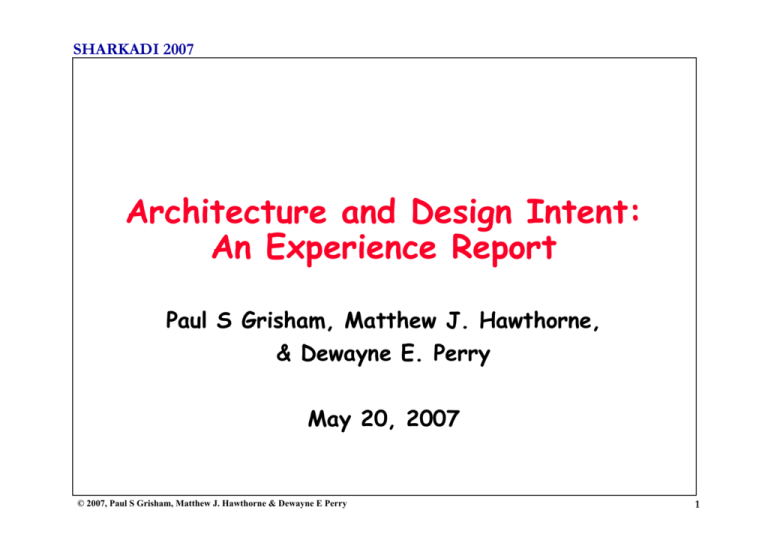
SHARKADI 2007 Architecture and Design Intent: An Experience Report Paul S Grisham, Matthew J. Hawthorne, & Dewayne E. Perry May 20, 2007 © 2007, Paul S Grisham, Matthew J. Hawthorne & Dewayne E Perry 1 SHARKADI 2007 Introduction Î What is Design Intent? ªSet of decision-making factors ¾ Rationale ¾ Best-Practices ¾ Patterns, Styles, Idioms ¾ Naturalistic Decision-making ¾ Situational Analysis Î Graduate Topics Course on Design Intent ªTeach theory, history, and current practices of AK and DI ªGoal: Use the project as a prototype study on DI modeling ¾ Gain preliminary results for hypothesis forming ¾ Improve methods for future studies © 2007, Paul S Grisham, Matthew J. Hawthorne & Dewayne E Perry 2 SHARKADI 2007 Overview of the Project Î Project overview: ª Add features to an existing software project ¾ Evolutionary design Î Project Phases: Î Problem Domain: 1. Infer DI/AK from unstructured documentation 2. Perform decision modeling without decision process 3. Perform decision modeling with decision process ª Document management system ª Extensive documentation covering all aspects of the system ¾ ¾ ¾ ¾ ¾ Executive summaries and white papers Informal architecture documentation User manuals Wikis / mailing list archives Source code (open-source) ª Mature, suitably complex ª Easy to understand domain © 2007, Paul S Grisham, Matthew J. Hawthorne & Dewayne E Perry 3 SHARKADI 2007 Phase 1 – Using Existing Knowledge Î Read documentation and answer specific questions ªWhere can certain knowledge be found? ¾ Functional requirements ¾ Architectural design ¾ Architectural rationale ªHow was rationale explicitly and implicitly represented? Î Results: ªDocs were suitably thorough to find basic functional and architectural design ¾ Relevant information was spread throughout multiple sources ¾ Subject to interpretation ¾ Difficult to terminate search without exhaustive reading ªRationale present, but subtle coding ¾ Students used content analysis ªSearches were disorganized ¾ Reflected immaturity of architects ¾ Lack of structure in documents © 2007, Paul S Grisham, Matthew J. Hawthorne & Dewayne E Perry 4 SHARKADI 2007 Phase 2 – Decision Modeling w/out process Î Treat requirements structuring as a design activity Î Use QOC to: ªformalize requirements (questions, constraints) and ªconsider early design alternatives (options) Î Students felt that the process helped them discover alternatives and hidden assumptions ªBut they couldn’t identify anything specific Î Students felt that it helped coordinate their group ªMore or less than other collaborative systems? © 2007, Paul S Grisham, Matthew J. Hawthorne & Dewayne E Perry 5 SHARKADI 2007 Phase 3 – Decision modeling with Process Î Use CBSP to structure requirements and map to arch elements ªTreats requirement structuring as a design activity ªDistinct steps with input and output artifacts ªOther architecture design processes not suitable for evolutionary design ªOther arch+rationale systems do not provide a design method Î Students found CBSP difficult to use ªSteps were incompletely defined or too vague ªCategories and classifications were too ambiguous ªLack of tool support and method guidance © 2007, Paul S Grisham, Matthew J. Hawthorne & Dewayne E Perry 6 SHARKADI 2007 Analysis of Problem Domain Î DSpace was a good domain choice ªCan be used for repeatable, controlled experiments ªHalf- to full-day observation studies with individuals or teams ªQuestion: How do experienced architects approach existing documentation for evolving domains? ªWe can “fake” AK or DI for DSpace to perform specific tests © 2007, Paul S Grisham, Matthew J. Hawthorne & Dewayne E Perry 7 SHARKADI 2007 Analysis of Method Î Decision-Support is useful ªAK as process by-product ªMany decision support processes are for initial design ¾ CBSP or Preskriptor (e.g.) not suitable for evolving designs Î General rationale modeling for architectural design is not that useful ªGeneral rationale systems have been studied more thoroughly and better in the past ªWe should be focusing on systems of integrating arch. design with AK Î Missed Opportunity – Round Trip ªIntegrate semiformal DI/AK into unstructured documentation as a comparison for the next iteration © 2007, Paul S Grisham, Matthew J. Hawthorne & Dewayne E Perry 8
